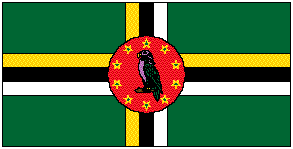



 |
|



|
|
|
||
|
|
||

|
Free Consulting
Spot Check information on DominicaFor all my Dominican/Canadian friends, just a reminder on a few points on our lovely Island. This page is simply designed for you, and I mean you, for only we can cherish the beauty that Dominica possesses! Try not to forget where we come from, and be proud of who you are! Love to all my friends all over the Caribbean and in Canada . Dominica, also known as the "Nature Isle of the Caribbean", is an exotic island and just the vacation spot for you. Situated between the twin French islands of Guadeloupe and Martinique, Dominica is the largest and highest of the windward islands. It is approximately 29 miles long by 16 miles wide, and covers an area of approximately 288 sq. miles(746 sq. km). The highest point is Morne Diablotin, which is 4,747 ft. above sea level. Recognized as one of the Caribbean islands with the most fresh-water rivers, Dominica is also known as "The Land of 365 Rivers", where you have a river for each day. Wether or not this is true(as I have never gotten the opportunity to check for myself), it is as close as possible to the truth. Water falls are one of the highlights of Dominica, along with the lush green scenery.More Info on DominicaNatural Beauty:The mountains abound with rivers swiftly flowing to the sea, providing wonderful fresh-water bathing, to be found no where else in the Caribbean. The profusion of tropical fruits and vegetables, dense tropical forests, deeep valleys, fast-flowing rivers and waterfalls, small geysers and hot springs,and wildlife, attract botanists, ornithologists, nature-lovers, hikers, and mountain climbers. The surrounding sea provides a fascinating underwater world for exploration br scuba divers. History: Waitikibuli(the Carib name of the island), was the last settlement of the Carib indians (who gave the Caribbean its name), and decendants still live in a reseved part of the island known as The Carib Reserve (north-eastern part of the island). The first European to see it was Christopher Columbus in 1493. The island changed hands between the British and the French several times until it finally became British possesion in 1805. Dominica gained independence in 1978. The official language of Dominica is English, but "patois" is also widely spoken, particularly by the elders. If you can speak French, you should be able to understand and be understood yourself to the islanders who don't speak English very well. English is the business language, so don't fret if you have to go to the bank or to the book store; they will speak perfectly to you! The island's culture exibits strong French influence. Pronounced as: Domink , officially Commonwealth of Dominica, republic (1995 est. pop. 82,000), consists of the island of Dominica (290 sq mi/750 sq km), located in the Windward Islands, West Indies. Roseau is the capital and chief port. The island, of volcanic origin, is mountainous and forested, with fertile soil. Dominica is subject to frequent destructive hurricanes. Administratively, the island is divided into ten parishes. The population is largely of African descent. More than three quarters of the inhabitants are Roman Catholics, the balance mainly Protestants. English is the official language, but a French patois is also widely spoken. Bananas are the chief commercial crop and export. Coconuts, citrus fruits, and coconut oil are also exported, and mangoes
and root crops are also raised. Industry is generally limited to food processing and the manufacture of soap and other
coconut-based products. Tourism is a growing industry, but Dominica remains one of the poorest Caribbean nations. Climate: |
|
|
|